The first part of the information on this page has been excerpted and adapted from A Brief History of Tassajara by Marilyn McDonald.
San Francisco Zen Center Opens a Monastery
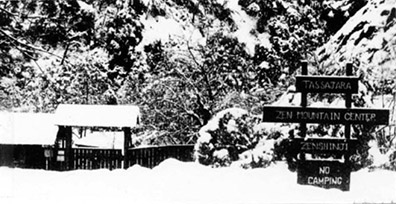
Shunryu Suzuki Roshi, a Zen master from Japan, came to San Francisco in 1959 to fill the position of resident priest of the Sokoji Buddhist temple on Bush Street. People began to join him in his meditation, and in the early 1960s the group that had formed was incorporated as the San Francisco Zen Center. Suzuki Roshi wanted a place in the mountains where Zen students could follow traditional practice, including meditation, study, and daily life. After looking at property in several different parts of California, he and his student Richard Baker found Tassajara. In early January 1967, with the help of hundreds of supporters, the Zen Center made the first payment towards the purchase of the Hot Springs property from the Becks (see earlier history of Tassajara). The opening day for Tassajara Zen Mountain Center, Zenshinji (the Japanese name) was on July 3, 1967. Over 150 people attended. The first training started the next day. It would be the only one held in the summer, that was two months instead of 90 days, and that allowed students to come for just part of it. It included not only people who had been practicing at the Zen Center, but also some from other groups and teachers. Over 80 people participated in part or whole.
Tassajara Zen Mountain Center was the first to have men, women, and couples practicing together. Because nothing quite like this has ever been done before, many aspects of monastic life had to be determined. Whether to wear temple-type robes or American style clothes? Which ceremonies to adopt? How to arrange the living space? Kobun Chino Sensei and Dainin Katagiri Sensei (both of whom would later be called roshi) assisted Suzuki Roshi in helping the new students. A few other priests from Japan came later.
The Buddhist also decided to continue having Tassajara open to guests during the summer, which presented its own set of problems. A great deal of time was spent during the first years deciding how the monastery would be organized. All this took place during the late 1960s, a time when many people in America were looking for a new lifestyle. Tassajara seemed attractive and different, but just dropping in during the practice periods but was not permitted. Wanderers were graciously offered use of the baths and a sack lunch and were sent back up the road. Drop-ins during the summer could become guest students for a short time if there was room. Those with a genuine interest in studying Zen Buddhism were and are encouraged to begin at the City Center in San Francisco, which offers a more formal introduction, with the possibility of returning to Tassajara for practice. No student at Tassajara is exempt from the schedule, and a person has to be serious, because there is no way to live in the situation and not be totally part of it.
Rebuilding and Remodeling
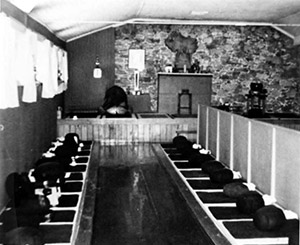
One of the first projects for the early Zen students was to remodel the old dining room and create a zendo, or meditation hall. The old kitchen had been condemned by the health department when the Becks owned the Springs. It was torn down in the first weeks by an overzealous Zen student caretaker acting on his own, who knew it was condemned and thought it looked too dilapidated. The small staff dining shed, which already had a four burner stove, was quickly converted into a temporary kitchen.
When the hotel burned in 1949, the sand stone blocks were bulldozed into the cellar. Many of these were dug up in the creation of a garden and used as foundation stones for the new kitchen. The walls were made from stones gathered in the creek bed. Roof timbers were cut from Coulter pine from Chew’s Ridge and from Tassajara canyon sycamore. No nails were used in the joints, which were made by traditional Danish and Japanese methods. None of the masons had ever build a stone building before. It was finished in 1970.
People didn’t want to use the square stones – they wanted to use the rounded pretty ones. It took a lot longer. Of course some people would hunt for a whole day to find the right stone for the right spot.
Paul Disco, head builder
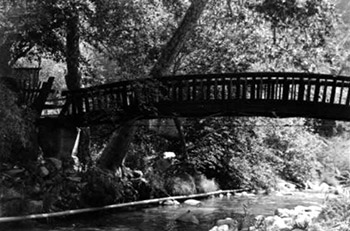 The baths were re-plastered and repainted and the second-story massage rooms, which were in very bad repair, were torn down. A carefully crafted arched bridge provided year-round access to the baths. The old clubhouse became the new dining room, with the rooms upstairs used as a student dormitory. In 1972 the porch was roofed and screened, doubling the dining capacity.
The baths were re-plastered and repainted and the second-story massage rooms, which were in very bad repair, were torn down. A carefully crafted arched bridge provided year-round access to the baths. The old clubhouse became the new dining room, with the rooms upstairs used as a student dormitory. In 1972 the porch was roofed and screened, doubling the dining capacity.
The student diet was lacto- ovo-vegetarian, with lots of brown rice and vegetables, beans, and fruit, and some eggs and dairy. Until 1970 the guest food included some meat and fish. This diet was difficult for some of the Zen students. Over the years, a vegetarian cuisine has evolved that satisfies the students and the guests, and keeps them healthy. The Tassajara Bread Book as well as Tassajara Cooking both derived from this cuisine.
Suzuki Roshi died on December 4, 1971. Shortly before his death he installed Richard Baker as chief priest and Abbot of Zen Center.
With the winter and spring rains, the road to Tassajara would wash out to some extent every year, some years rendering it impossible for a time, until the road crew could get in. Each year it gets a little better. The Monterey County Road Crew has developed an understanding of the road’s contours and watershed requirements; they discovered that if they put dips where the washouts occur the water would not collect but would run off, preventing heavy damage to the road.
In 1973 the Zen Center leased the old Jamesburg house and the snack bar, and later purchased the property. It has served as a quite useful halfway house, rest station, and place to park the car to go in on the Tassajara stage. A new building was constructed at Tassajara in 1975. It has six sleeping rooms, all opening on an inner courtyard. Construction incorporated Japanese building techniques, and one of the features was composting toilets at the back of the building. At 3- room yurt, built in 1982, was fashioned after the circular, domed tents used by nomadic herdsmen in Siberia. It was built near the swimming pool. The cabins down the lane are much the same as when they were built in the late 1920s.
Two Fires
In August 1977 the Big Sur-Marble Cone fire, which burned 200,000 acres of the Los Padres National Forest, almost destroyed Tassajara. Laura Burges, a Zen student, remembered,
“The Forest Service insisted that we evacuate. It was very strange leaving Tassajara in this long caravan of cars and going up the road, and sort of looking back and wondering if we’d ever see it again.“
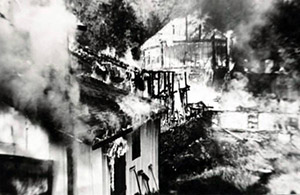 At one point the fire surrounded the monastery. With the aid and guidance of the Forest Service Hotshot Crews, backfires were set by Baker Roshi and a few students with firefighting training. The burned watershed created flooding the following winter and spring, and in January 1978, Tassajara Creek went over the top of the steam room and into the plunges; there were landslides in the canyon and the Tassajara Road washed out in six places.
At one point the fire surrounded the monastery. With the aid and guidance of the Forest Service Hotshot Crews, backfires were set by Baker Roshi and a few students with firefighting training. The burned watershed created flooding the following winter and spring, and in January 1978, Tassajara Creek went over the top of the steam room and into the plunges; there were landslides in the canyon and the Tassajara Road washed out in six places.
In April 1978 the old dining room/zendo burned down. This fire may have started in the basement storage area in a propane gas refrigerator. The wood in the building was so old and dry that it burned rapidly. A knew zendo was immediately constructed. The room on the west end of the [old zendo] building was rebuilt in 1982 and is now the office.
We were in there having a ceremony at the end of the training period, and suddenly this voice from the back said “hey, there’s a fire back here.” We all turned around and there’s this rosy glow – luckily the door was close so it contained the fire long enough for us all to get out.
Laura Burges
It is 1985, and the Zen Buddhist have been at Tassajara for 18 years. Although Tassajara is a monastery, it is also a place where in the summer guests can enjoy the mountains, bathe in the hot springs, or join the Zen students in work or meditation. It is open to guests from May through September. Reservations are required. It has been 110 years since Jack Borden advertised that Tassajara Springs was “open to visitors.” There have been many changes: fires, floods, new buildings, and new owners; yet Tassajara remains a very special place.
The saying is, “One trip to Tassajara assures you will want to be a yearly visitor as long as you live.”
AFTERWORD
by David Chadwick, 2018
Marilyn McDonald’s a brief history of Tassajara brings us up to the time thirty-three years ago when the San Francisco Zen Center had been the owner of that beloved place for eighteen years. For almost a century before the Zens as we were often called, Tassajara had been principally associated with one or two hearty individuals who settled, homesteaded, bought, and ran it. With Zen Center in charge, however there’s been a gradual turnover of resident students and teachers. We have been there for fifty-one years, slowly catching up with the Quiltys, whose reign covered a span of sixty. Now Tassajara‘s caretaker is a spiritual community, as I envision it had been for millennia before the descendants of Europeans came.
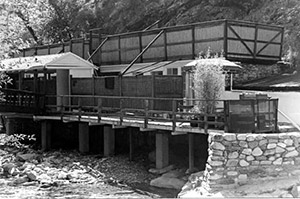 There have been some developments since 1985. The structural integrity of the old bathhouse had gotten a failing grade from our own engineer and so it was rebuilt, and quite nicely, ready for the 1986 guest season. The paint had hardly dried when geological engineers deemed the steep hillside above with a huge looming boulder unstable. So, since 1996 the bridge leads to a roofless ruined, and the newer new plungers and steam rooms are upstream a bit on the north side of the creek by the path. The stone rooms were redone in the late 80s using the original walls, and a handful of cabins have been replaced. Also still standing are the original stone walls from the zendo that burned down in 1978. It’s part of a dining area again, open air, screened in with a roof for student meals in the guest season and work periods. In the late 90s, the charming old dining hall with nine dorm rooms above was rebuilt along with the deck to look and feel much the same, still with hand hewn logs from the mountain in the ceiling of what once was called the Club House. Tassajara is now almost completely on solar power, including some beautiful solar lamps replacing the old smoky kerosene ones. There’s been development just about everywhere, from the entryway, shops, pool area, gardens, landscaping, upper and lower barn, to Grasshopper Flats out beyond the baths.
There have been some developments since 1985. The structural integrity of the old bathhouse had gotten a failing grade from our own engineer and so it was rebuilt, and quite nicely, ready for the 1986 guest season. The paint had hardly dried when geological engineers deemed the steep hillside above with a huge looming boulder unstable. So, since 1996 the bridge leads to a roofless ruined, and the newer new plungers and steam rooms are upstream a bit on the north side of the creek by the path. The stone rooms were redone in the late 80s using the original walls, and a handful of cabins have been replaced. Also still standing are the original stone walls from the zendo that burned down in 1978. It’s part of a dining area again, open air, screened in with a roof for student meals in the guest season and work periods. In the late 90s, the charming old dining hall with nine dorm rooms above was rebuilt along with the deck to look and feel much the same, still with hand hewn logs from the mountain in the ceiling of what once was called the Club House. Tassajara is now almost completely on solar power, including some beautiful solar lamps replacing the old smoky kerosene ones. There’s been development just about everywhere, from the entryway, shops, pool area, gardens, landscaping, upper and lower barn, to Grasshopper Flats out beyond the baths.
The Kirk Creek fire in 1999 threatened Tassajara but didn’t get there. The massive Big Basin fire of 2008, however, did creep in from all sides, and five monks who defied the mandatory evacuation saved the place, as is well recorded in Fire Monks: Zen Mind Meets Wildfire at the Gates of Tassajara by Colleen Morton Busch.
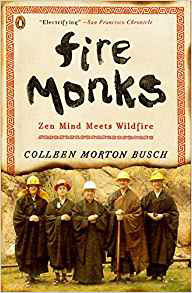 In response to a request from me for an update on Tassajara since 1985, Leslie James, appropriately at Jamesburg, wrote:
In response to a request from me for an update on Tassajara since 1985, Leslie James, appropriately at Jamesburg, wrote:
One change of Tassajara now is that we offer many retreats. Most people who come have some relationship with, or at least curiosity about, Buddhism or meditation. People still come for the serenity and a rest from their busy lives, but Tassajara is quieter than the old days. The work periods started in 1986 in April and September, when skilled workers and others come to help us maintain Tassajara in the interim between guest season and practice. What a blessing.
Prior owners made a noble effort to maintain and run Tassajara so well. None had the budget, or the army of residence and volunteers, or received donations and grants like Zen Center does. For these new Buddhist caretakers though, the wonderful hot water from the springs is not the focus. Nor is the isolated natural setting, nor the bright stars at night. Zen Buddhist practice is why the residents are there. Fortunately for them and for the guests, that practice includes the springs, the creek, the sky at night, working hard, and taking good care of guests and each other without thinking or talking about it too much.
Fires 2020
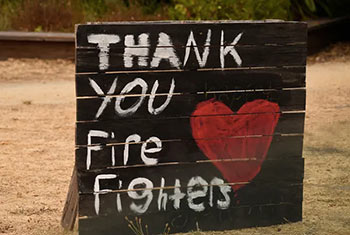
In mid-August 2020 there were three active fires in Monterey County: the River Fire (near Salinas), the Carmel Fire (Cachagua Road near Jamesburg), and the Dolan Fire (Big Sur, close to Esalen). The Dolan Fire grew to 2500 acres overnight and eventually came to within a few miles of Tassajara. A small crew of people with fire fighting experience and knowledge of the terrain and systems stayed while the rest of the people living there evacuated. Professional fire crews came into Tassajara. In mid-September, the danger had diminished to the extent that the crew members who had been there for a month were able to leave to take a rest. Other SFZC residents began to return to Tassajara. As of October 9, the fires were sufficiently contained for Tassajara to be considered no longer in danger. For the full unfolding of the story, see the Fire Updates page.